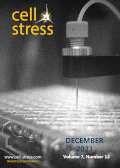Table of contents
Volume 7, Issue 12, pp. 105 - 111, December 2023
Cover: This month in
Cell Stress: a screening platform for senolytic compounds. Image credit: Andreas Zimmermann. Image modified by
Cell Stress. The cover is published under the
CC BY 4.0 license.
Enlarge issue cover
A versatile method for the identification of senolytic compounds
Chiara Annunziata, Francesca Castoldi, Jan Schlegel, Hazel X. Ang, Mina Ristovska, Stefania Melini, Robert Welch, Christian G. Riedel and Federico Pietrocola
Research Reports |
page 105-111 | 10.15698/cst2023.12.292 | Full text | PDF |
Abstract
The increased burden of senescent cells is as a well-established hallmark of aging and age-related diseases. This finding sparked significant interest in the identification of molecules capable of selectively eliminating senescent cells, so-called senolytics. Here, we fine-tuned a method for the identification of senolytics that is compatible with high-content fluorescence microscopy. We used spectral detector imaging to measure the emission spectrum of unlabeled control or senescent cells. We observed that senescent cells exhibited higher levels of autofluorescence than their non-senescent counterparts, particularly in the cytoplasmic region. Building on this result, we devised a senolytic assay based on co-culturing quiescent and senescent cells, fluorescently tagged in the nuclear region through the overexpression of H2B-GFP and H2B-RFP, respectively. We validated this approach by showing that first generation senolytics were effective in reducing the number of RFP+ nuclei leaving the count of GFP+ nuclei unaffected. The result was confirmed by flow cytometry analysis of nuclei isolated from these quiescent-senescent cell co-cultures. We found that this system enables to capture cell type-specific effects of senolytics as in the case of fisetin, which kills senescent Mouse Embryonic Fibroblasts but not senescent human melanoma SK-MEL-103 cells. This approach is amenable to genetic and chemical screening for the discovery of senolytic compounds in that it overcomes the limitations of current methods, which rely upon costly chemical reagents or fluorescence microscopy using cells labeled with fluorescent cytoplasmic probes that overlap with the autofluorescence signal emitted by senescent cells.



